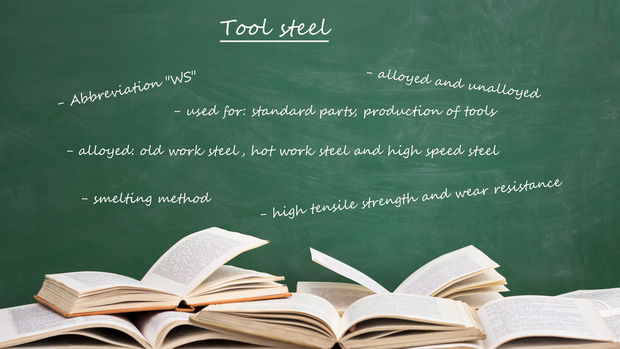Tool steel is one way to classify steel with the abbreviation "WS".
The consumption of tool steel is about 1 million tonnes per year.
A distinction is made between alloyed and unalloyed tool steel.
Alloyed tool steel is suitable for tools that are subjected to higher stresses and
does not warp as much during hardening. The alloying elements include chromium,
manganese, molybdenum, nickel or tungsten. With alloyed tool steel,
a further distinction is made between cold work steel, hot work steel and high speed steel.
Cold work tool steel is suitable for operating temperatures of up to 200°C,
whereas hot work tool steel is used at operating temperatures of 200°C and above.
High-speed steel is suitable for the highest operating temperatures up to 600°C.
Unalloyed tool steel is not suitable for such high operating temperatures as alloyed tool steel.
For this reason, it is mostly cold work steel. Its carbon content is between 0.5% and 1.5% and
it contains some tungsten. Unalloyed tool steel is also not through-hardenable.
The properties of tool steel include high tensile strength and wear resistance.
Furthermore, it has a high hardness despite the high toughness of some steels.
Some of the tool steels are also corrosion-resistant or suitable for high temperatures,
such as the high-speed steel mentioned above.
They can be machinable, i.e. suitable for milling or turning.
Iron is needed to produce tool steel. In this process, 75% of the tool steel is produced from scrap iron using the smelting method and 25% of the tool steel is produced by smelting iron ore. In short, iron ore and coke are first processed into pig iron, this process is called the smelting process. Then the refining into steel takes place. The smelting process is expensive because it takes place in an electric arc furnace.
There, scrap with sponge iron, pig iron and lime is liquefied at 3500°C to form steel. The liquid steel now flows into a vacuum plant, where sulphur and phosphorus are removed. Next comes purification by the SU method. Here, substances such as oxygen, nitrogen, manganese or lead are removed. In the slag bath, sulphur and non-metallic inclusions are now absorbed by the slag and thus separated from the melt.
Finally, the molten metal solidifies into a block. In the case of alloyed tool steel, metals are added before solidification. The slag is a by-product of tool steel production. As the name of the steel suggests, tool steel is used for the production of tools.
Do you wish to have a component made from tool steel with the help of contract manufacturing? Make an enquiry.
All you have to do is upload your drawing to PART FACTORY, specify a quantity and we will contact you with a market-driven quotation.
and we will get back to you with an offer in line with the market.
Try it out and make an enquiry today.


